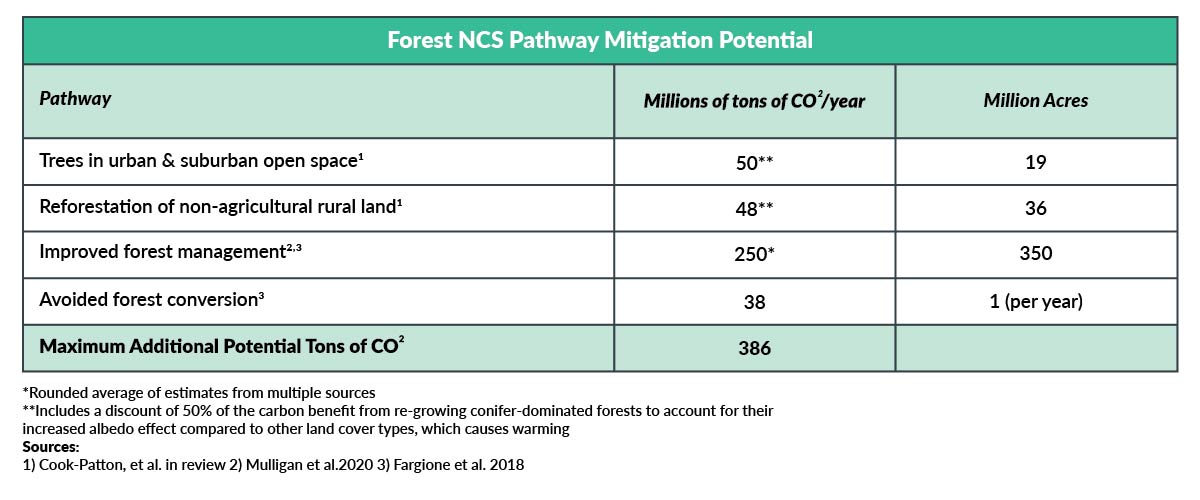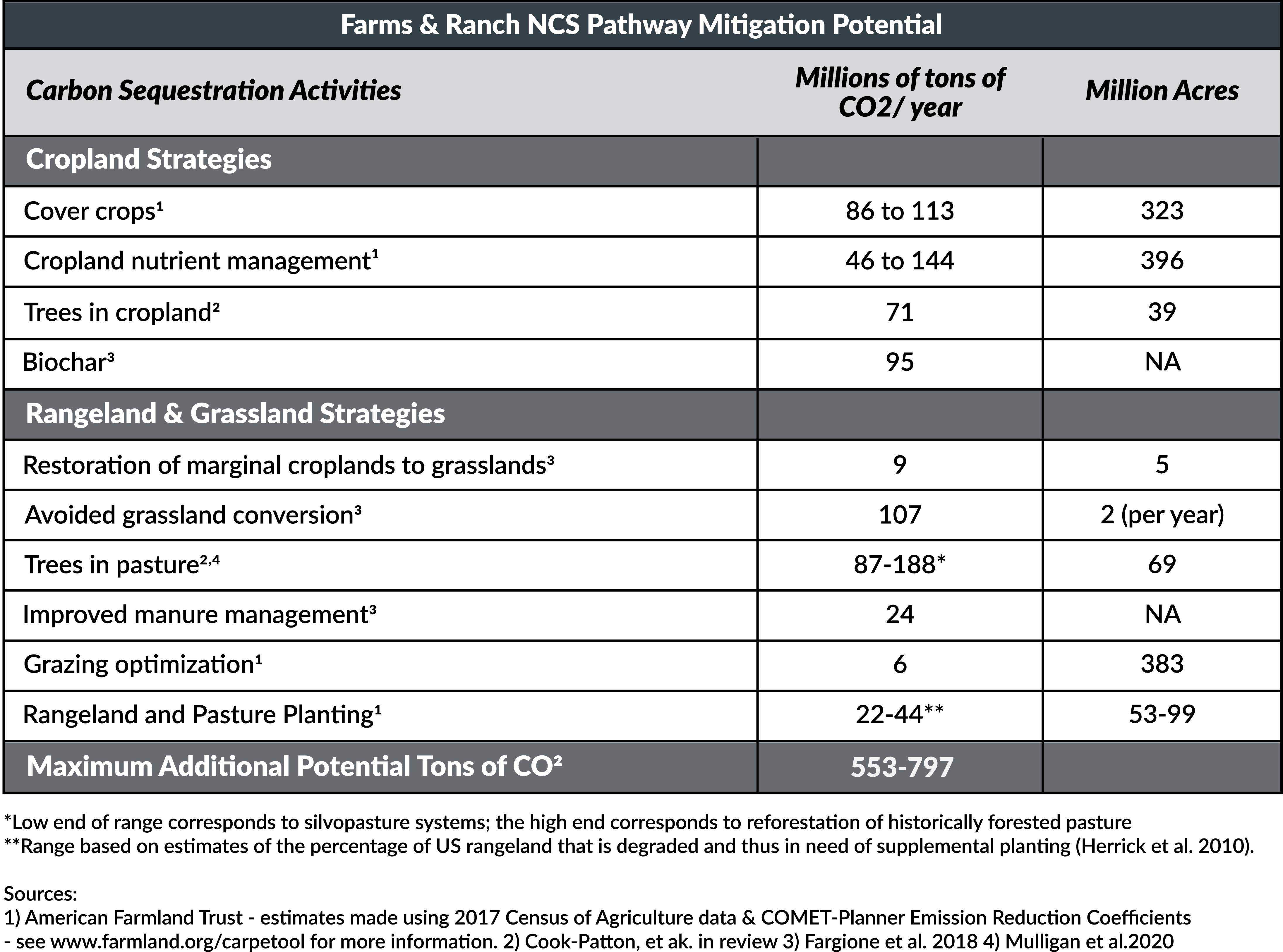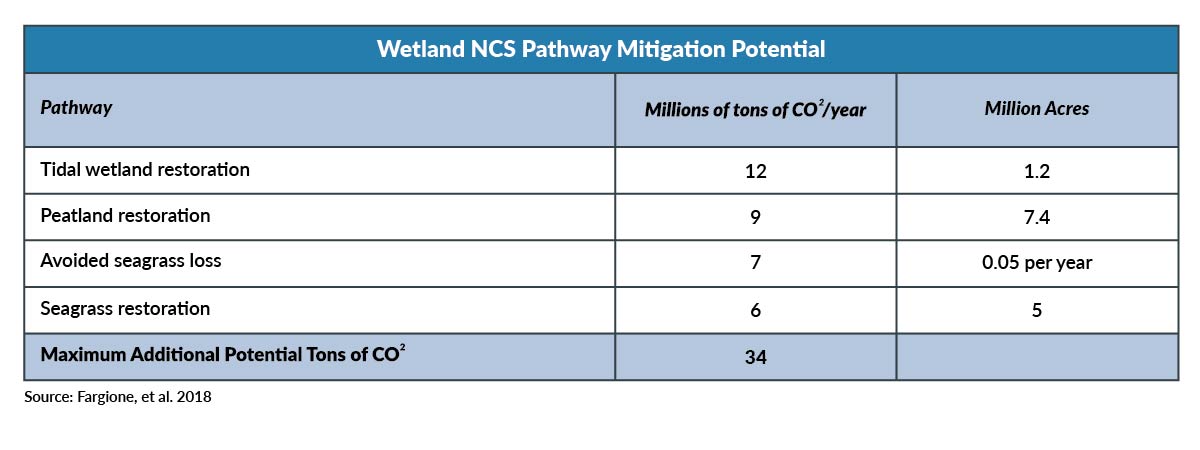Trees and Forests
The United States’ 823 million acres of forest lands, managed by public land managers, Native American Tribes, forestry companies, families, and cities can play a crucial role in our efforts to mitigate climate change. Historically, there were an estimated 1 billion acres of forest lands in the United States. Approximately 1 million acres of forests are converted to other uses each year. Preventing the conversion of forests to agriculture or development keeps carbon on the landscape instead of in the atmosphere. Planting more trees in urban areas and replanting a portion of the historically forested lands outside our cities, improving management to keep forests growing faster and longer, and effectively managing forests to sequester more carbon would also generate significant climate mitigation benefits. In total, researchers estimate that these forest practices can increase sequestration in our forests and urban areas by 386 million metric tons of carbon dioxide per year.
Not only do these practices help address climate change, they can prevent soil erosion and improve water quality, enhance habitat for fish and wildlife habitat, and make our communities healthier and safer.

Learn how forests can be part of the solution to climate change:
-
Avoided Forest Conversion
Each year, approximately 1 million acres of forests in the United States are converted to other uses such as development and cropland. Retaining existing forests that would otherwise be converted to other land uses can prevent the emission of 38 million metric tons of carbon dioxide per year.
-
Improved Forest Management
A variety of management practices can increase carbon sequestration in forests, including extending timber rotations and restocking degraded forests, limiting grazing by animals, actively managing forest pest impacts, and controlling competition from invasive plants. These practices could collectively sequester up to about 250 million additional tons of carbon dioxide per year.
-
Reforestation Strategies
- Increasing urban tree cover by planting trees along streets and in parks can sequester up to 50 million tons of carbon dioxide a year, while also providing an opportunity to improve tree equity in low-income neighborhoods.
- Reforestation outside of cities, cropland, and pasture can sequester 48 million tons of carbon dioxide per year. This includes actions like restoring biodiversity corridors and riparian buffers along streams and on frequently flooded landscapes and post-fire restocking.
Agricultural Lands and Grasslands
In the United States, about 16% of the country’s land area, or 396 million acres, is cultivated to produce crops. Intensive cultivation practices have impacted a large proportion of the original soil carbon in croplands. By changing management of croplands, we can store more carbon in the soil, prevent soil erosion, improve water quality and, in many places, increase the productivity of the land. Increasing productivity, in turn, can ease pressures to convert natural forests and grasslands to food production in the U.S. and abroad.
Many of these practices, like cover crops have already been adopted by numerous farmers. At the same time, research is underway to determine the carbon mitigation potential of other agricultural practices, like composting, crop rotations and planting deep rooted crops, and to determine the scalability of innovative practices like biochar and alley cropping. By advancing research and applying a variety of innovative and proven management practices that reduce agricultural emissions or enhance carbon sinks, America’s farms can be an important part of the solution to climate change.
Taking action to preserve and improve the management of America’s pasture and rangelands can also help mitigate climate change. In the U.S., pasturelands and rangelands cover about 401 million acres – more than twice the size of Texas. Pasture and rangelands store high levels of carbon in their soils. A significant fraction of that carbon has been lost through conversion to cropland and overgrazing. Taking additional steps to protect and improve grazing practices on pastures and grasslands would provide significant carbon benefits, while also protecting habitat for wildlife and safeguarding our water.

Learn how agricultural lands & grasslands can be part of the climate solution:
-
Cover crops
Growing a cover crop in the fallow season between market crops has the potential to remove between 86 to 113 million metric tons of carbon dioxide from the atmosphere, depending on the mix of legume and non-legume cover crops.
-
Cropland nutrient management
Replacing 15% of synthetic nitrogen applications with dairy or beef feedlot manure would reduce the equivalent of 46 million metric tons of carbon dioxide emissions. Replacing 15% synthetic nitrogen with compost that has a 25:1 C:N ratio would reduce the equivalent of 144 million metric tons of carbon dioxide emissions.
-
Trees in cropland
Planting windbreaks adjacent to croplands could sequester an additional 11 million metric tons of carbon dioxide in above and below-ground biomass and soils, while reducing wind erosion. Planting fruit and nut trees in alleyways between row crops such as corn and soybeans could sequester an additional 60 million metric tons of carbon dioxide.
-
Biochar
Biochar is produced from agricultural and forestry waste in a controlled process called pyrolysis. Based on available agricultural and forestry waste, amending agricultural soils with biochar could sequester up to 95 million metric tons of carbon dioxide. In addition to sequestering carbon, biochar amendments increase the moisture holding capacity of the soils.
-
Grassland restoration
Restoring 5 million acres of marginal cropland to grasslands to build carbon in soils and root biomass could help sequester an additional 9 million metric tons of carbon dioxide per year. This is equivalent to returning to the 2007 peak in Conservation Reserve Program enrollment.
-
Avoided grassland conversion
Retaining grasslands that would otherwise be converted to cropland or other uses could help reduce carbon emissions by up to 107 million metric tons per year.
-
Trees in pastures
Planting trees in historically forested pastureland offers another opportunity for storing carbon. Integrating trees into pasture lands while maintaining livestock production – a practice known as silvopasture – could sequester as much as 87 million tons of carbon dioxide per year, while full reforestation of these lands could sequester up to 188 million tons of carbon dioxide per year.
-
Grazing optimization
Grazing optimization on rangeland and planted pastures could store an additional 6 million metric tons of carbon dioxide. This practice is referred to as ‘prescribed grazing’ and involves managing the harvest of vegetation with grazing or browsing animals. It assumes intensively-managed grazing on the land (i.e., 40% forage removal) at 21-day intervals.
-
Improved manure management
Avoided methane emissions from dairy and hog manure through improved management practices could reduce emissions by the equivalent of 24 million metric tons of carbon dioxide a year.
-
Rangeland and pasture plantings
Replanting degraded rangelands and sowing legumes in planted pastures could sequester an additional 21 million metric tons of carbon dioxide in rangeland and pasture soils.
Wetlands
Protecting and restoring coastal ecosystems, such as mangroves, salt marshes and seagrass beds—or “blue carbon,” has a relatively low global mitigation potential due to the smaller acreage these systems can occupy compared to other ecosystems, but the per acre sequestration potential is high. In addition, protecting and restoring coastal wetlands often provides significant benefits to society: protecting coastal communities, supporting ocean fisheries, enhancing tourism, and improving water quality that can be worth many thousands of dollars per acre per year. For example, scientists estimate that US coastal wetlands provide $23.2 billion in storm protection services each year.
Freshwater wetlands cover less than 5% of the world’s land area but store vast quantities of carbon per acre in the form of peat soils. Protecting peatlands and rewetting and restoring drained peatlands can prevent massive carbon emissions, reduce destructive peat fires, and improve water quality.

Learn how wetlands can be part of the climate solution:
-
Tidal wetland restoration
Restoring tidal flows to salt marshes that have been disconnected from the ocean has the potential to remove the equivalent of 12 million metric tons of carbon from the atmosphere by reducing methane emissions.
-
Peatland restoration
Damaged peatlands are a major source of greenhouse gas emissions, annually releasing almost 6% of global anthropogenic CO2 emissions (IUCN 2017). Peatland restoration in the U.S. can therefore bring significant emissions reductions. Restoring peatlands could avoid 9 million metric tons of carbon dioxide emissions.
-
Avoided seagrass loss
By protecting seagrass we can avoid up to 7 million metric tons of CO2 emissions.
-
Seagrass restoration
Up to 6 million metric tons of carbon dioxide could be sequestered by restoring the estimated 29 to 52% of historic seagrass extent that has been lost and could be restored.
